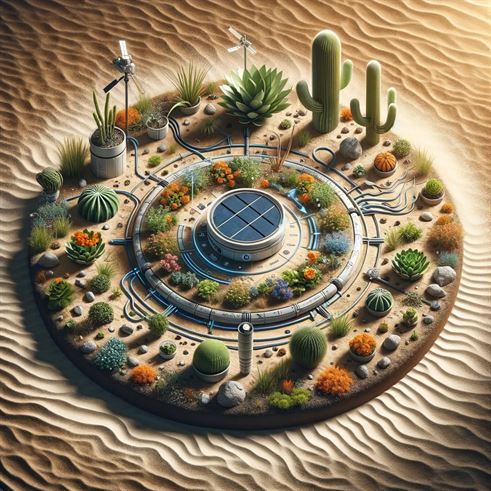Gardening in dry climates presents unique challenges, with water scarcity being a primary concern. However, it also offers an opportunity to explore creative and sustainable gardening practices.
By understanding the nuances of arid environments and employing water-efficient techniques, you can cultivate a thriving garden that respects and adapts to its natural surroundings. This comprehensive guide will delve into the best practices for gardening in dry climates, focusing on water conservation and efficient gardening methods.

Understanding Dry Climate Gardening
Gardening in dry climates requires a shift in mindset and practices. It involves recognizing the limitations of water availability and adapting your gardening techniques to minimize water usage while maximizing plant health and productivity.
It’s about working with the environment, not against it.
Choosing the Right Plants
Select plants that are well-suited to dry conditions. Native plants and drought-tolerant species are ideal choices as they have adapted to thrive with minimal water.
Consider succulents, cacti, and hardy perennials that require less frequent watering.
Soil Preparation and Mulching
Healthy soil is crucial for water retention. Amend your soil with organic matter to improve its structure and water-holding capacity.
Use mulch around your plants to reduce water evaporation, regulate soil temperature, and prevent weed growth. Organic mulches like straw, bark chips, or compost are excellent options.
Efficient Watering Techniques
Watering wisely is key in dry climates. Use drip irrigation systems to deliver water directly to the roots of plants, minimizing waste.
Water early in the morning or late in the evening to reduce evaporation. Collect rainwater when possible to supplement your watering needs.
Embracing Xeriscaping Principles
Xeriscaping is a gardening style that emphasizes water efficiency. It involves choosing drought-tolerant plants, reducing lawn areas, and creating garden zones based on water needs.
Xeriscaping can lead to a beautiful, low-maintenance garden that thrives in dry conditions.
Creating Windbreaks and Shade
Wind and direct sun can quickly dry out plants and soil. Use windbreaks such as fences, walls, or shrubs to protect your garden from drying winds.
Plant shade trees or use shade cloths to shield plants from intense sunlight, especially during the hottest parts of the day.
Water Conservation Practices
Adopt practices that conserve water. Use soaker hoses or drip irrigation instead of sprinklers, and fix any leaks promptly. Group plants with similar water needs together to avoid overwatering less thirsty plants.
Utilizing Container Gardening
Container gardening can be a water-efficient option in dry climates. Containers allow for better control of soil moisture and can be placed in optimal locations for water conservation.
Choose pots with good drainage and water them carefully to avoid water waste.
Implementing Rainwater Harvesting
Collecting rainwater can significantly supplement your garden’s water supply. Install rain barrels or cisterns to capture runoff from rooftops.
Even in dry climates, the water collected during rare rains can be a valuable resource for your garden.
Reducing Lawn Areas
Lawns are often water-intensive. Consider reducing lawn areas and replacing them with drought-tolerant ground covers, gravel, or hardscaping. This not only saves water but also reduces maintenance.
Organic Gardening Practices
Organic gardening practices, such as composting and using natural pest control methods, can enhance soil health and reduce water needs. Healthy soil retains water more effectively and supports stronger plant growth.
Regular Monitoring and Maintenance
Regularly check your garden for signs of stress or water needs. Adjust your watering schedule based on weather conditions and the needs of your plants.
Timely maintenance, such as pruning and weeding, can also improve water efficiency.
Educating Yourself and Others
Stay informed about the latest water-saving gardening techniques and share your knowledge with others. Participating in community gardening groups or workshops can provide valuable insights and tips for gardening in dry climates.
Celebrating the Beauty of Dry Climate Gardens
Embrace the unique beauty of dry climate gardens. These landscapes can be stunning, with a wide variety of textures, colors, and forms.
Appreciate the resilience and elegance of plants that thrive under the sun’s intense gaze.
Cultivating Resilience in Dry Climates
Gardening in dry climates can be a rewarding and sustainable endeavor.
By adopting water-efficient practices, choosing the right plants, and respecting the natural limitations of arid environments, you can create a thriving garden that is both beautiful and environmentally conscious.
Embrace the challenge and enjoy the unique beauty of dry-climate gardening.














